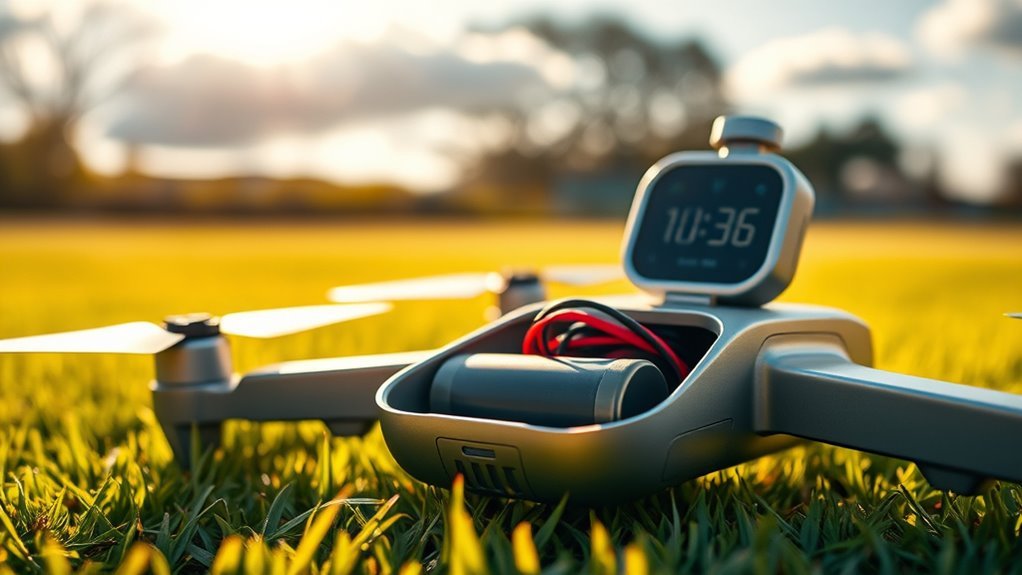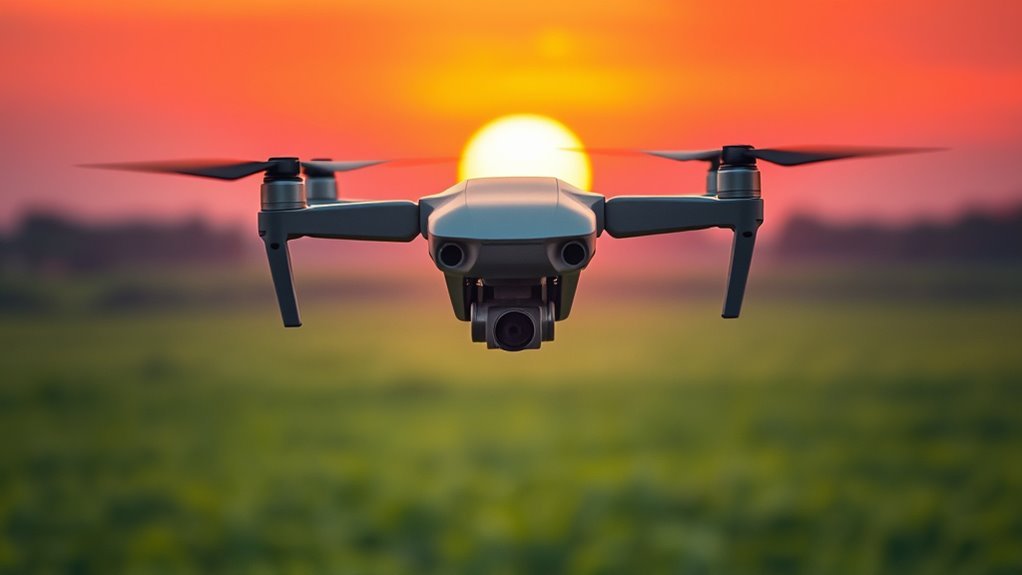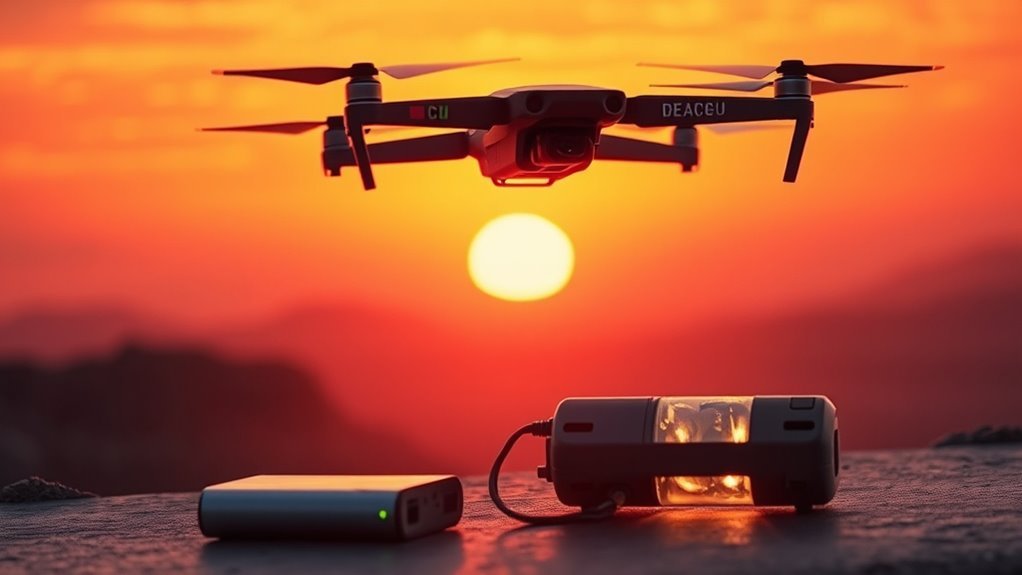You can expect drone batteries to last between 15 and 30 minutes per charge, influenced by battery type, drone weight, and flight conditions. Lithium polymer batteries offer high energy density but are sensitive to temperature extremes and payload weight, which reduce efficiency. Proper maintenance, including avoiding deep discharges and charging in ideal conditions, extends battery life. Understanding these factors helps maximize flight time and battery health, and exploring battery technology and usage tips will further enhance your drone’s performance.
Understanding Drone Battery Types

Although there are various power sources for drones, lithium polymer (LiPo) batteries dominate the market due to their high energy density and lightweight design. When selecting a battery, you must consider battery lifespan and battery compatibility carefully. LiPo batteries provide excellent power-to-weight ratios, enabling longer flight durations without sacrificing maneuverability. However, their lifespan depends on factors like charge cycles, storage conditions, and discharge rates. Using batteries incompatible with your drone risks damage and reduced efficiency, so always verify voltage, capacity, and connector type compatibility. Understanding these technical parameters empowers you to maintain peak performance and extend battery longevity, granting you the freedom to explore without frequent interruptions. Mastering battery types ensures you maximize flight potential while safeguarding your investment in drone technology.
Average Flight Time for Consumer Drones

Most consumer drones offer a flight time ranging between 15 to 30 minutes per battery charge, depending on factors like battery capacity, drone weight, and power consumption. When you fly, maximizing battery longevity hinges on understanding these parameters and how they interact with flight efficiency. Lightweight designs typically enhance efficiency, allowing you to stay airborne longer without increasing battery size. Conversely, heavier drones demand more power, reducing flight duration despite larger batteries. Advances in battery technology have incrementally extended average flight times, but you still need to balance capacity with weight to optimize performance. By analyzing typical flight scenarios and energy consumption rates, you can better anticipate realistic flight times, enabling you to plan missions that align with your desire for extended freedom in the air.
Factors Influencing Battery Life

You’ll find that the type of battery chemistry greatly affects overall performance and longevity. Environmental temperatures also play a critical role, as extreme heat or cold can degrade capacity and efficiency. Additionally, your drone’s flight patterns—such as aggressive maneuvers versus steady hovering—directly influence how quickly the battery drains.
Battery Chemistry Types
Because the chemistry of a drone’s battery directly impacts its energy density, discharge rate, and overall lifespan, understanding these types is essential for enhancing flight performance. Lithium Polymer (LiPo) batteries dominate due to their high energy density and favorable power-to-weight ratio, extending your battery lifespan and flight time. In a chemistry comparison, Lithium-Ion (Li-ion) offers higher energy density but lower discharge rates, making it less suitable for high-performance drones. Nickel-Metal Hydride (NiMH) and Nickel-Cadmium (NiCd) are largely obsolete due to inferior energy density and memory effect issues, which reduce usable capacity over time. By selecting the best battery chemistry, you maximize your drone’s operational freedom, balancing weight, power output, and cycle longevity to suit your specific flying needs without compromising reliability or safety.
Environmental Temperature Effects
Although battery chemistry plays an essential role, the environmental temperature greatly affects your drone battery’s performance and lifespan. Temperature extremes can cause capacity loss, voltage drops, and internal resistance changes, directly impacting flight time and battery health. Seasonal variations further complicate battery management, requiring adjustments to charging and storage protocols. You should consider these factors:
- Cold temperatures slow chemical reactions, reducing capacity and increasing internal resistance, which limits flight duration.
- High temperatures accelerate degradation, causing irreversible capacity loss and potential safety risks.
- Rapid temperature fluctuations stress battery materials, leading to premature wear and decreased cycle life.
Flight Patterns Impact
When your drone executes aggressive flight maneuvers or maintains high speeds, the battery experiences increased current draw, which accelerates voltage depletion and internal heat generation. Flight patterns directly influence battery efficiency by dictating power consumption rates. Smooth, steady flight conserves energy, while erratic or rapid directional changes increase load. Understanding these patterns lets you optimize flight time and extend operational freedom.
| Flight Pattern | Battery Efficiency Impact | Description | Energy Demand |
|---|---|---|---|
| Steady Hover | High | Minimal movement, stable altitude | Low |
| Slow Linear Flight | Moderate | Constant speed, straight path | Moderate |
| Aggressive Maneuvers | Low | Rapid turns, climbs, descents | High |
| High-Speed Flight | Very Low | Sustained max speed | Very High |
Selecting appropriate flight patterns maximizes battery longevity for your drone.
Impact of Weather Conditions on Battery Performance
If you operate your drone in extreme temperatures, you’ll notice a significant reduction in battery efficiency and overall flight time. Temperature fluctuations directly impact the chemical reactions inside lithium-polymer batteries, lowering their voltage output and capacity. Additionally, wind resistance increases motor workload, accelerating battery drain. Here’s how weather affects your battery:
- Cold conditions slow down electrochemical processes, causing up to 30% less flight time.
- Excessive heat can degrade battery cells, reducing lifespan and peak performance.
- High winds force your drone to exert more power to stabilize, further decreasing battery endurance.
Understanding these factors lets you plan flights with precision, maximizing your drone’s freedom without unexpected power loss. Always monitor weather to protect battery health and extend your airborne experience.
How Payload Affects Flight Duration
When you add payload to your drone, its weight increases, directly impacting flight duration. Heavier payloads require more energy to maintain lift, which accelerates battery depletion. Understanding this relationship helps you optimize flight time by balancing payload weight and power consumption.
Payload Weight Impact
Although drone batteries are designed to provide ideal energy storage, the payload weight you carry considerably influences flight duration. Your drone’s payload capacity sets the maximum weight limit for peak performance, but exceeding or nearing this limit drastically reduces flight time. Proper weight distribution is equally critical; uneven loads force the motors to work harder, accelerating battery drain. To maximize flight duration, consider these factors:
- Stay well below the payload capacity to prevent excessive power demand.
- Balance the payload evenly to avoid compensatory motor strain.
- Regularly assess how added equipment impacts battery life and adjust accordingly.
Energy Consumption Increase
Since additional payload increases the power demand on your drone’s motors, energy consumption rises proportionally with weight. This directly impacts energy efficiency and challenges battery optimization efforts. Understanding this relationship helps you maximize flight duration while carrying necessary equipment.
| Payload (grams) | Flight Time Reduction (%) |
|---|---|
| 0 | 0 |
| 250 | 12 |
| 500 | 25 |
| 750 | 40 |
As payload increases, battery drain accelerates, forcing more frequent recharges or larger battery capacity. To maintain freedom in flight, you must balance payload weight with your drone’s energy efficiency, optimizing battery use without compromising mission objectives. Prioritize minimal payload whenever possible to extend operational range and duration.
Battery Maintenance Best Practices
Proper battery maintenance is essential to maximize the lifespan and performance of your drone’s power source. To extend battery lifespan and guarantee reliability, adhere to strict maintenance schedules. Here are three best practices:
- Regular Inspection: Examine your battery for physical damage, swelling, or corrosion before every flight, as compromised cells reduce capacity and safety.
- Storage Conditions: Store batteries at a stable temperature (ideally 20°C/68°F) and maintain a 40-60% charge to slow chemical degradation.
- Cycle Management: Avoid deep discharges and excessive full charge cycles; partial discharges followed by timely recharging preserve cell integrity.
Charging Tips to Maximize Battery Health
To maximize your drone battery’s lifespan, you should follow ideal charging practices, such as avoiding overcharging and using the manufacturer’s recommended charger. Proper storage, including maintaining a partial charge and storing in a cool environment, plays an essential role in preserving battery health. These strategies help minimize capacity loss and extend overall battery performance.
Optimal Charging Practices
Although drone batteries are designed for convenience, how you charge them greatly affects their longevity. To maximize your battery’s lifespan, follow these ideal charging tips rooted in battery longevity strategies:
- Use the manufacturer’s recommended charger to guarantee proper voltage and current, preventing overcharging or overheating.
- Avoid charging batteries to 100% capacity regularly; instead, aim for about 80–90% to reduce stress on the lithium polymer cells.
- Charge in a temperature-controlled environment between 20°C and 25°C to maintain chemical stability and prevent capacity degradation.
Storage and Maintenance
When storing your drone batteries, you’ll want to maintain them at a partial charge—typically around 40-60%—to prevent capacity loss and chemical degradation. Proper battery storage is critical; avoid leaving batteries fully charged or completely drained for extended periods, as this accelerates wear. Additionally, keep batteries in a cool, dry environment, ideally between 15-25°C (59-77°F), to minimize thermal stress. Regular maintenance practices include checking voltage levels monthly and recharging to the ideal storage charge when necessary. Avoid exposing batteries to extreme temperatures or moisture, which can compromise cell integrity. By following these targeted storage and maintenance practices, you maximize battery health and lifespan, ensuring your drone remains ready for flight whenever freedom calls. Prioritize these steps to maintain reliable power and enhance performance.
Signs Your Drone Battery Needs Replacement
How can you tell if your drone battery is nearing the end of its lifespan? Recognizing battery warning signs early lets you maintain flight freedom without unexpected interruptions. Here are three precise replacement signs to monitor:
- Rapid Capacity Drop: If your battery discharges considerably faster than usual, it indicates diminished cell efficiency.
- Inconsistent Voltage Readings: Fluctuating voltage during use or charging signals internal degradation affecting power stability.
- Physical Deformities: Swelling, leakage, or corrosion on the battery casing are critical failure indicators requiring immediate replacement.
Comparing Lithium-Polymer Vs Lithium-Ion Batteries
Recognizing the signs that your drone battery needs replacement is just one part of managing flight performance. When comparing Lithium-Polymer (LiPo) and Lithium-Ion (Li-ion) batteries, a clear battery capacity comparison reveals that Li-ion cells generally offer higher energy density, extending flight times. However, LiPo batteries excel in discharge rate analysis, supporting rapid energy release essential for agile maneuvers and quick throttle responses. LiPo’s superior discharge rates provide better power delivery, but typically at the cost of shorter overall lifespan and increased sensitivity to physical stress. Conversely, Li-ion batteries deliver longer cycle life but lower peak current output, which might limit dynamic flight capabilities. Understanding these trade-offs allows you to choose the battery type that best aligns with your desire for freedom—whether prioritizing extended flight duration or responsive control.
Innovations in Drone Battery Technology
Although traditional lithium-based batteries have dominated the drone market, recent innovations are rapidly advancing energy storage solutions to enhance flight time, safety, and reliability. You’ll find three key breakthroughs shaping the future:
- Solid state batteries: Offering higher energy density and improved thermal stability, they drastically reduce fire risks while extending flight duration.
- Advanced battery recycling: New methods recover valuable materials efficiently, reducing environmental impact and supply chain dependencies.
- Smart battery management systems: These optimize charging cycles and monitor health in real-time, ensuring peak performance and longer battery lifespan.

